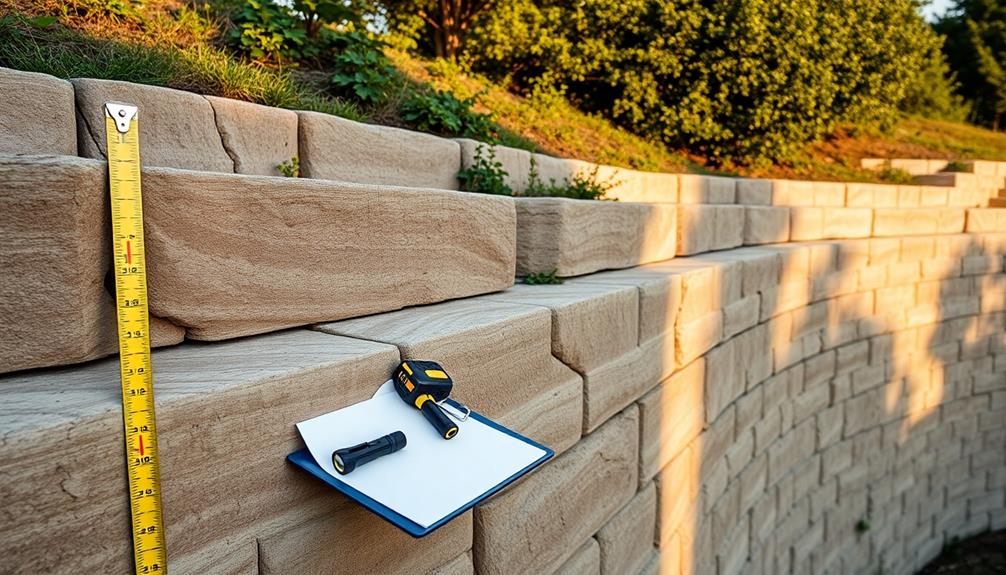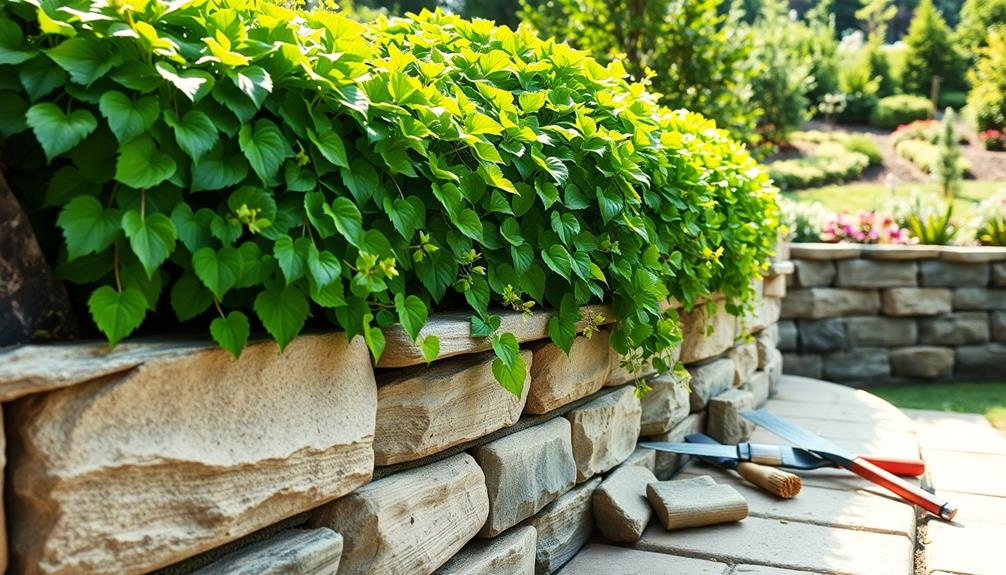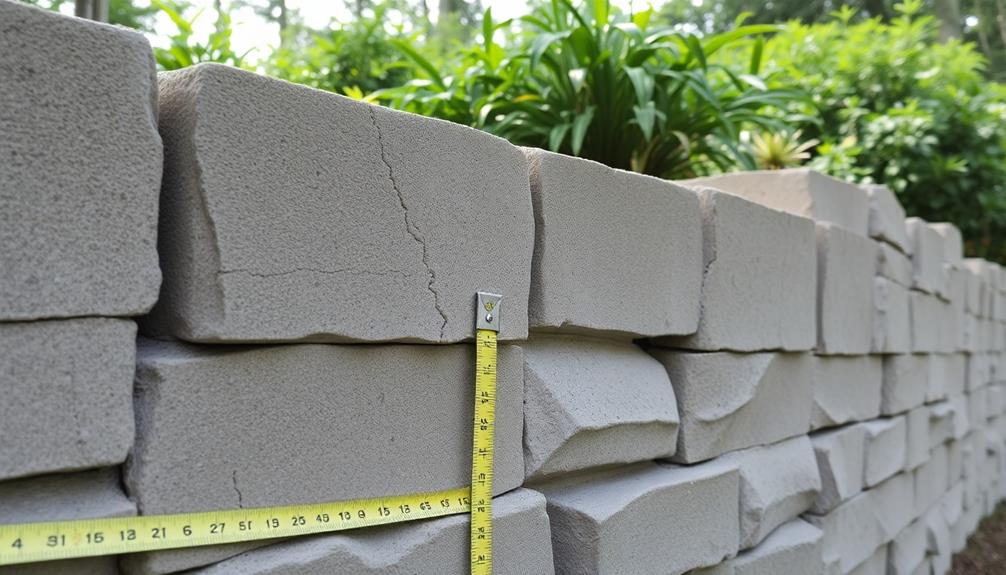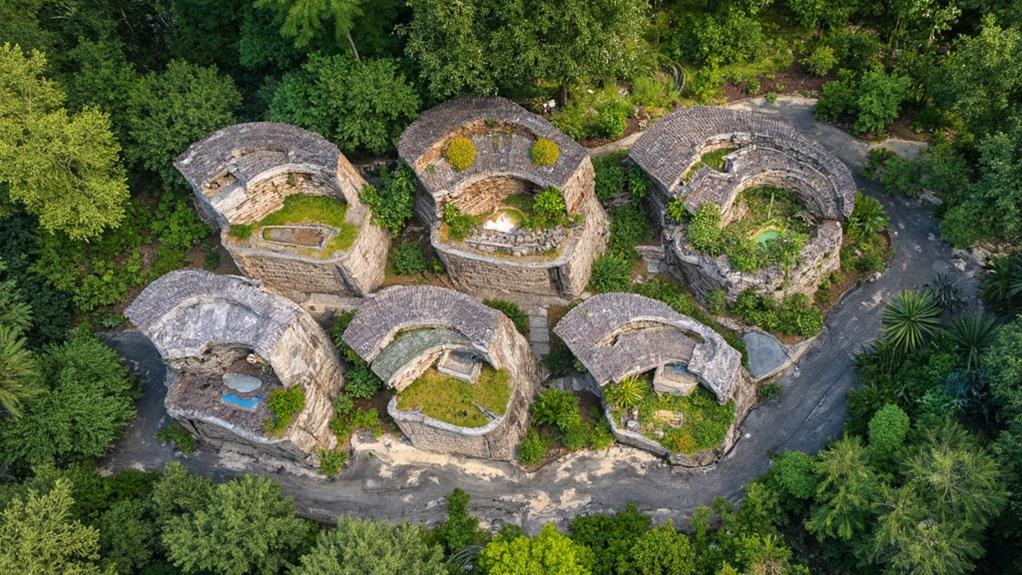The top five maintenance best practices for retaining walls encompass routine visual inspections, measurement of wall movement, thorough documentation, property value enhancement, and improved structural integrity. Regular examinations should focus on identifying cracks, bulges, misalignments, and signs of erosion or moisture-related issues. Precise monitoring of wall movement using advanced surveying techniques helps detect subtle changes over time. Detailed documentation of inspections, including photographs and measurements, facilitates informed decision-making and trend analysis. Proper maintenance not only increases property value by enhancing curb appeal but also fortifies the wall against soil pressure, water infiltration, and freeze-thaw cycles. Understanding these practices provides a solid foundation for ensuring the longevity and performance of retaining walls.
Table of Contents
ToggleWalls Contractor Highlights
- Conduct routine visual inspections to identify cracks, bulges, or misalignment in the wall surface.
- Measure wall movement using survey markers or advanced technologies like LiDAR for early problem detection.
- Maintain comprehensive documentation of inspections, including photographs, measurements, and observed anomalies.
- Clear vegetation and debris from the wall's base and drainage systems to prevent water accumulation.
- Address minor repairs promptly to prevent small issues from escalating into major structural problems.
Regular Inspection and Monitoring

Regular inspection and monitoring form the cornerstone of effective retaining wall maintenance, ensuring structural integrity and early detection of potential issues. By collaborating with landscape architects and structural engineers, property owners can enhance the functionality and visual appeal while maintaining proper drainage and erosion control.
A thorough inspection routine encompasses visual checks for damage, precise measurements of wall movement, and meticulous documentation of all findings. These practices, when implemented consistently, allow property owners and maintenance professionals to track changes over time, identify emerging problems, and take proactive measures to prevent costly failures or safety hazards.
Visual Checks for Damage
One of the most essential aspects of retaining wall maintenance is conducting routine visual inspections for signs of damage or deterioration. As fellow property owners and managers, we appreciate the significance of preserving the structural integrity of our retaining walls. By implementing a systematic approach to visual checks, we can identify potential issues before they escalate into costly repairs or safety hazards.
During these inspections, it is pivotal to examine the wall's surface for cracks, bulges, or shifts in alignment. Pay close attention to areas where water may accumulate, as moisture can accelerate deterioration. Look for signs of erosion at the base of the wall and inspect drainage systems to guarantee proper functionality. Additionally, assess the condition of any visible reinforcement elements, such as steel bars or geotextiles. Document your findings meticulously, including photographs and detailed notes, to track changes over time and facilitate informed decision-making regarding maintenance and repairs. By adhering to a rigorous visual inspection protocol, we collectively contribute to the longevity and safety of our retaining wall structures, ultimately protecting our investments and safeguarding the well-being of our communities.
Measuring Wall Movement
Implementing a systematic approach to measuring wall movement is essential for maintaining the integrity and safety of retaining walls. This process involves regular monitoring and documentation of any changes in the wall's position, alignment, or overall structure.
By establishing a baseline measurement and conducting periodic assessments, property owners and maintenance professionals can detect subtle shifts that may indicate potential issues before they escalate into critical problems.
To effectively measure wall movement, consider the following techniques:
- Install survey markers or monitoring points along the wall's face and crest
- Utilize precision instruments such as total stations, laser scanners, or inclinometers
- Employ digital photogrammetry or LiDAR technology for extensive 3D modeling
These methods enable the detection of minute changes in wall position, tilt, or deformation over time. By maintaining detailed records of these measurements, we can identify trends and patterns that may necessitate intervention. Regular analysis of this data allows for informed decision-making regarding maintenance schedules, repairs, or potential reinforcement measures.
Ultimately, a proactive approach to measuring wall movement contributes to the longevity and reliability of retaining structures, ensuring the safety of our communities and the stability of our built environments.
Documenting Inspection Findings
A detailed record of inspection findings serves as the backbone of effective retaining wall maintenance. Diligent documentation allows property owners and maintenance teams to track changes over time, identify recurring issues, and make informed decisions about necessary repairs or interventions.
When documenting inspection findings, it is paramount to include extensive information such as the date and time of inspection, weather conditions, specific areas of concern, and any observed anomalies or deviations from previous inspections.
Photographs and detailed sketches should accompany written descriptions, providing visual evidence of the wall's condition and any identified problems. Measurements of cracks, bulges, or displacements should be recorded with precision, using standardized units and referencing fixed points for consistency. It is also essential to note any external factors that may influence the wall's performance, such as nearby construction activities or changes in drainage patterns.
Benefits

Maintaining a retaining wall through regular inspection and upkeep yields numerous advantages that extend beyond mere aesthetics. By guaranteeing that soil is kept in place, retaining walls help prevent erosion which can otherwise compromise the stability of a property.
Homeowners and property managers who invest in proper retaining wall care can expect to see an increase in their property's overall value, as well as enhanced structural integrity that affirms the wall continues to perform its essential function. Additionally, consistent maintenance improves safety measures by identifying potential hazards early on, while simultaneously extending the wall's lifespan, consequently providing long-term cost savings and peace of mind for property owners.
Increased Property Value
Properly maintained retaining walls can substantially boost a property's overall value. These structures not only serve a functional purpose but also contribute significantly to the aesthetic appeal and structural integrity of a property. By investing in regular maintenance, homeowners can confirm their retaining walls remain in ideal condition, enhancing the overall attractiveness and marketability of their property.
A well-maintained retaining wall offers several benefits that directly impact property value:
- Enhanced curb appeal, creating a polished and professional landscape appearance
- Increased usable outdoor space, expanding the functional area of the property
- Prevention of soil erosion and potential structural damage to the main building
Real estate professionals consistently emphasize the importance of a property's exterior presentation. A sturdy, visually appealing retaining wall can make a lasting impression on potential buyers, setting the property apart from others in the market. Additionally, a properly maintained retaining wall demonstrates responsible homeownership, instilling confidence in prospective purchasers about the overall care and upkeep of the property. This attention to detail can translate into higher offers and a quicker sale process, ultimately maximizing the return on investment for homeowners.
Enhanced Structural Integrity
While retaining walls serve various aesthetic and functional purposes, their primary role lies in providing essential structural support. Regular maintenance practices greatly enhance the structural integrity of these crucial landscape elements, ensuring their longevity and ideal performance. By implementing a thorough maintenance regimen, property owners can fortify their retaining walls against the relentless forces of nature, including soil pressure, water infiltration, and freeze-thaw cycles.
A well-maintained retaining wall exhibits superior load-bearing capacity, effectively resisting lateral earth pressures and preventing soil erosion. This enhanced structural integrity is achieved through meticulous inspection routines, prompt repair of cracks or damaged components, and proper drainage management. Vigilant upkeep also mitigates the risk of sudden wall failure, which could lead to catastrophic consequences for both the property and its occupants.
Furthermore, a structurally sound retaining wall contributes to the overall stability of the surrounding landscape, safeguarding adjacent structures and maintaining the aesthetic appeal of the property. By prioritizing the structural integrity of retaining walls through diligent maintenance practices, property owners demonstrate their commitment to preserving the safety, functionality, and value of their investments.
Improved Safety Measures
The implementation of improved safety measures stands as a paramount benefit of consistent retaining wall maintenance. By regularly inspecting and addressing potential hazards, property owners can greatly reduce the risk of accidents and liabilities associated with wall failures. These safety enhancements not only protect individuals in the vicinity but also safeguard valuable assets and infrastructure.
A thorough safety protocol for retaining walls typically includes:
- Installation of proper drainage systems to prevent water accumulation and erosion
- Reinforcement of structural elements to withstand environmental stresses
- Implementation of warning signs and barriers in high-risk areas
Through diligent maintenance practices, we collectively contribute to a safer environment for our communities. The longevity and stability of retaining walls are greatly enhanced when safety measures are prioritized, ensuring that these structures continue to serve their intended purposes effectively. By adhering to industry-standard safety protocols, property owners demonstrate their commitment to responsible stewardship and community well-being. This proactive approach not only mitigates potential risks but also fosters a sense of security among those who interact with or reside near these essential landscape features.
Extended Lifespan
One of the most significant benefits of regular retaining wall maintenance is the substantial extension of the structure's lifespan. By implementing a thorough maintenance program, property owners and managers can effectively mitigate the natural wear and tear that occurs over time, ensuring their retaining walls remain functional and aesthetically pleasing for years to come. This proactive approach not only preserves the structural integrity of the wall but also safeguards the investment made in its initial construction.
Regular inspections and timely repairs address minor issues before they escalate into major problems, potentially saving thousands of dollars in costly replacements or extensive renovations. Additionally, proper maintenance practices, such as cleaning, sealing, and repointing, protect the wall materials from environmental factors like moisture infiltration, freeze-thaw cycles, and UV radiation. These measures drastically slow down the deterioration process, allowing the retaining wall to maintain its strength and stability for an extended period. By prioritizing ongoing maintenance, property owners demonstrate their commitment to long-term value and sustainability, fostering a sense of pride and belonging among community members who appreciate well-maintained infrastructure.
Check for Signs of Settlement

Regularly checking for signs of settlement is vital in maintaining the integrity and longevity of retaining walls. Careful inspection can reveal soil gaps, changes in wall alignment, and potential foundation instability, all of which indicate underlying structural issues. The following table outlines key indicators of settlement, potential causes, and recommended actions to address these problems:
| Indicator | Potential Cause | Recommended Action |
|---|---|---|
| Soil Gaps | Erosion or Drainage Issues | Improve Drainage Systems |
| Wall Misalignment | Soil Pressure or Structural Weakness | Consult Structural Engineer |
| Foundation Instability | Poor Soil Conditions or Water Infiltration | Conduct Soil Analysis and Reinforce Foundation |
Inspect for Soil Gaps
How can you detect early signs of potential retaining wall failure? One essential aspect to monitor is the presence of soil gaps. These voids between the wall and the soil it's meant to retain can indicate serious structural issues. As a responsible property owner or manager, regularly inspecting for these gaps is critical to maintain the integrity of your retaining wall and protect the safety of your landscape.
When conducting your inspection, look for the following indicators:
- Visible spaces between the wall and soil, especially near the base
- Soil erosion or washout areas behind the wall
- Bulging or leaning sections of the wall, which may create gaps
Soil gaps often result from poor drainage, inadequate compaction during construction, or settlement over time. Left unchecked, these voids can lead to increased hydrostatic pressure, compromising the wall's stability. By identifying and addressing soil gaps early, you can prevent more severe damage and potentially costly repairs. Implement a regular inspection routine, ideally after heavy rainfall or significant temperature fluctuations, to catch these issues before they escalate. Proactive maintenance not only preserves your investment but also safeguards the longevity and effectiveness of your retaining wall structure.
Monitor Wall Alignment
Maintaining proper wall alignment is a key factor in preventing retaining wall failure. As a conscientious property owner or manager, it is essential to regularly monitor your retaining wall for signs of settlement or misalignment. These indicators can manifest as visible tilting, bulging, or horizontal displacement of the wall face. Such deviations from the original design may signify underlying structural issues or soil instability that require prompt attention.
To effectively monitor wall alignment, consider implementing a systematic approach. Establish reference points along the wall's length and height, then use a level or plumb bob to measure any deviations from vertical or horizontal planes. Document these measurements over time, creating a thorough record of the wall's performance. This data will prove invaluable in identifying gradual shifts that might otherwise go unnoticed. Additionally, observe the surrounding landscape for telltale signs of movement, such as cracks in nearby pavements or changes in drainage patterns. By maintaining vigilance and addressing alignment issues early, you can greatly extend the lifespan of your retaining wall and protect your property investment.
Assess Foundation Stability
A stable foundation is paramount to the longevity and performance of any retaining wall. Regular assessment of foundation stability is essential for identifying potential issues before they escalate into costly repairs or structural failures.
When evaluating foundation stability, property owners and maintenance professionals should be vigilant for signs of settlement, which can manifest in various ways.
Key indicators of foundation instability include:
- Visible cracks or fissures in the wall or surrounding soil
- Uneven or tilting wall sections
- Water accumulation or erosion at the base of the wall
To conduct a thorough assessment, begin by visually inspecting the entire length of the wall, paying close attention to the base and surrounding ground. Utilize specialized tools such as level meters and inclinometers to measure any deviations from the original design specifications. If settlement is suspected, it may be necessary to engage geotechnical experts to perform soil borings and analyze subsurface conditions.
Walls Contractor FAQ
How Long Does a Typical Retaining Wall Last?
The lifespan of a typical retaining wall varies depending on materials and maintenance. Generally, well-constructed walls can last 50-100 years. Regular inspections and proper care are essential for longevity, ensuring our shared spaces remain safe and functional for generations.
Can Plants Be Grown Near or on Retaining Walls?
Yes, plants can be grown near or on retaining walls. This practice not only enhances aesthetics but also contributes to soil stability. Choose appropriate species and guarantee proper drainage to protect the wall's integrity and create a welcoming environment.
What Are the Best Materials for Building Retaining Walls?
The best materials for building retaining walls include concrete blocks, poured concrete, natural stone, timber, and gabion baskets. Each option offers unique benefits, allowing you to choose a material that aligns with your project's aesthetic, durability, and budget requirements.
How Often Should Retaining Walls Be Professionally Inspected?
Professional inspections of retaining walls should occur annually, with more frequent checks in high-risk areas or after extreme weather events. Regular inspections help guarantee structural integrity and safety, allowing us to address potential issues proactively as a community.
Are There Specific Seasonal Maintenance Tasks for Retaining Walls?
Yes, there are seasonal maintenance tasks for retaining walls. Spring cleaning includes debris removal and checking for winter damage. Summer involves weed control and drainage inspection. Fall requires preparation for freeze-thaw cycles, while winter necessitates snow management and ice prevention.







